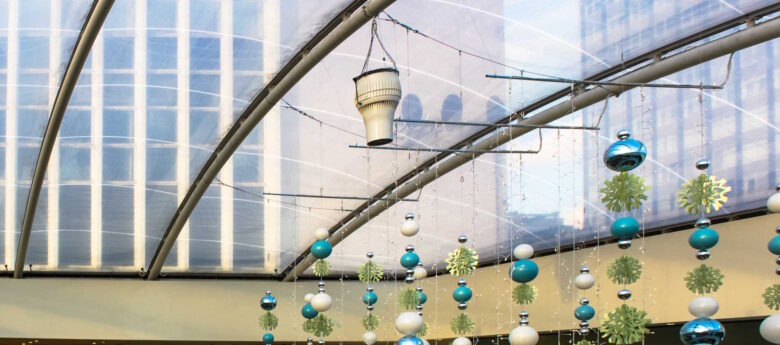Maximizing HVAC Efficiency: The Role of Destratification Fans

Effective management of indoor temperatures while minimizing energy consumption is a constant priority for facility managers across various industries. Temperature stratification – where warm air accumulates near the ceiling while cooler air remains at lower levels – presents a significant challenge for heating, ventilation and air conditioning systems.
Destratification fans offer a practical solution, facilitating improved temperature control and substantial cost savings. In this article, we explore the mechanisms of destratification fans and their impact on HVAC systems.
Understanding Temperature Stratification
Temperature stratification occurs due to differences in air density caused by variations in temperature. In buildings with high ceilings, temperature stratification occurs naturally. Warm air rises to the ceiling and cooler air collects near the floor, resulting in an uneven distribution of air temperatures.
Consequently, the design and layout of a building also influence temperature stratification, with tall, narrow spaces more prone to stratification than wide, open areas. Different building materials absorb and retain heat differently, affecting temperature distribution.
This phenomenon leads to discomfort for occupants and places added strain on HVAC systems as they struggle to maintain consistent temperatures throughout the space. Properly designed systems should consider factors such as air circulation, ventilation and zoning to minimize temperature differentials within the building.
Understanding temperature stratification is essential for optimizing building energy efficiency, maintaining occupant comfort and creating more comfortable indoor environments.
The Role of Destratification Fans
By implementing appropriate design strategies, HVAC system controls and destratification fans, building owners and operators can minimize temperature differentials and maximize indoor environment comfort.
Destratification fans should be strategically positioned to address temperature differentials by continuously mixing and redistributing air. Unlike traditional ceiling fans, destratification fans focus on vertical airflow, gently pushing warm air trapped at the ceiling downward while mixing with cooler air from the floor.
But won’t fans make it feel cooler? While increased air movement can cause an evaporative cooling effect on the skin, destratification fans effectively reduce temperature stratification, maintaining more uniform temperatures and improved comfort levels for building occupants. Proper selection and application of destratification technology can minimize any unwanted drafts. Additionally, smart controls can dynamically adjust airspeed based on room needs.
By distributing warm ceiling air uniformly, destratification fans unlock numerous advantages crucial in addressing building temperature stratification.
Benefits of Destratification Fans
Enhanced comfort: By eliminating temperature differentials, destratification fans create a more comfortable indoor environment, free from hot and cold spots – even in areas with high ceilings or large open spaces. Consistent temperatures throughout the space contribute to improved occupant satisfaction and productivity.
Energy efficiency: Destratification fans optimize HVAC system performance by reducing heating and cooling equipment workload. These high-efficiency, low-energy fans promote air circulation and reduce the need for overheating or overcooling, which helps minimize energy consumption and lower utility costs.
Cost savings: The energy savings achieved with destratification fans translate into significant cost savings for facility managers. Using destratification fans can save up to 30% on heating costs. Milan Lumber Company, as the below example illustrates, realized substantial reductions in its HVAC equipment-related expenses after installing destratification fans throughout the facility.
Environmental control: Temperature differentials can lead to spoilage or product integrity issues when storing products on high racks. Controlling the environmental air temperature from ceiling to floor helps maintain product integrity while maximizing the total storage volume.
Improved air quality: Offering more than just temperature control, destratification fans can also be equipped with air purification technology to improve indoor air quality, effectively reducing viruses, bacteria, molds and other harmful microorganisms in the air.
How Milan Lumber Company Improved HVAC Efficiency With Destratification Fans
Faced with challenges in temperature control and escalating energy expenses, Milan Lumber Company opted to implement destratification fans to enhance efficiency and reduce HVAC system cycling in its manufacturing facility. Destratification is particularly important during the company’s cold New Hampshire winters.
By addressing temperature stratification and promoting air circulation throughout the facility, Milan Lumber Company noticeably improved indoor comfort levels and significantly reduced energy consumption.
As a result, the company eliminated the need for an additional 1.5 million BTUs of heating equipment while keeping the indoor environment comfortable for the manufacturing team. Recently, the temperature dropped to -28 degrees Fahrenheit outside, and with the Airius destratification fans installed, the temperature at the floor never dipped below the setpoint of 60° F.
Why Incorporate Destratification Fans Into Your Building’s HVAC Strategy?
From promoting comfort and energy efficiency to optimizing HVAC system performance, destratification fans are a cost-effective solution to create a more pleasant indoor environment. Whether retrofitting an existing building or planning a new construction project, incorporating destratification fans is a smart investment that pays dividends in comfort and savings.
As demonstrated by Milan Lumber Company, implementing destratification fans can lead to improved comfort levels, reduced energy consumption and substantial cost savings for facility managers. As organizations strive to achieve greater sustainability and efficiency in their operations, destratification fans emerge as a practical and valuable tool for enhancing indoor comfort and minimizing energy costs.
Christian Avedon is the director of sales & marketing of Airius, a Colorado-based technology company focused on developing products that manage indoor air quality. Over the past 13 years, he has successfully assisted thousands of customers in selecting and applying Airius destratification fan systems for their buildings.
